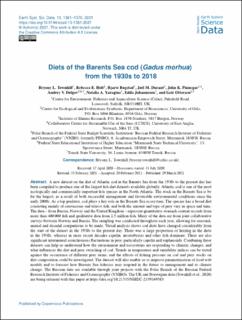| dc.contributor.author | Townhill, Bryony | |
| dc.contributor.author | Holt, Rebecca Emma | |
| dc.contributor.author | Bogstad, Bjarte | |
| dc.contributor.author | Durant, Jo l M. | |
| dc.contributor.author | Pinnegar, John K. | |
| dc.contributor.author | Dolgov, Andrey V. | |
| dc.contributor.author | Yaragina, Natalia A. | |
| dc.contributor.author | Johannesen, Edda | |
| dc.contributor.author | Ottersen, Geir | |
| dc.date.accessioned | 2021-09-29T09:51:09Z | |
| dc.date.available | 2021-09-29T09:51:09Z | |
| dc.date.created | 2021-09-07T11:10:47Z | |
| dc.date.issued | 2021 | |
| dc.identifier.citation | Earth System Science Data. 2021, 13 (3), 1361-1370. | en_US |
| dc.identifier.issn | 1866-3508 | |
| dc.identifier.uri | https://hdl.handle.net/11250/2785956 | |
| dc.description.abstract | A new dataset on the diet of Atlantic cod in the Barents Sea from the 1930s to the present day has been compiled to produce one of the largest fish diet datasets available globally. Atlantic cod is one of the most ecologically and commercially important fish species in the North Atlantic. The stock in the Barents Sea is by far the largest, as a result of both successful management and favourable environmental conditions since the early 2000s. As a top predator, cod plays a key role in the Barents Sea ecosystem. The species has a broad diet consisting mainly of crustaceans and teleost fish, and both the amount and type of prey vary in space and time. The data – from Russia, Norway and the United Kingdom – represent quantitative stomach content records from more than 400 000 fish and qualitative data from 2.5 million fish. Many of the data are from joint collaborative surveys between Norway and Russia. The sampling was conducted throughout each year, allowing for seasonal, annual and decadal comparisons to be made. Visual analysis shows cod diets have changed considerably from the start of the dataset in the 1930s to the present day. There was a large proportion of herring in the diets in the 1930s, whereas in more recent decades capelin, invertebrates and other fish dominate. There are also significant interannual asynchronous fluctuations in prey, particularly capelin and euphausiids. Combining these datasets can help us understand how the environment and ecosystems are responding to climatic changes, and what influences the diet and prey switching of cod. Trends in temperature and variability indices can be tested against the occurrence of different prey items, and the effects of fishing pressure on cod and prey stocks on diet composition could be investigated. The dataset will also enable us to improve parametrization of food web models and to forecast how Barents Sea fisheries may respond in the future to management and to climate change. The Russian data are available through joint projects with the Polar Branch of the Russian Federal Research Institute of Fisheries and Oceanography (VNIRO). | en_US |
| dc.language.iso | eng | en_US |
| dc.title | Diets of the Barents Sea cod (Gadus morhua) from the 1930s to 2018 | en_US |
| dc.type | Peer reviewed | en_US |
| dc.type | Journal article | en_US |
| dc.description.version | publishedVersion | en_US |
| dc.source.pagenumber | 1361-1370 | en_US |
| dc.source.volume | 13 | en_US |
| dc.source.journal | Earth System Science Data | en_US |
| dc.source.issue | 3 | en_US |
| dc.identifier.doi | 10.5194/essd-13-1361-2021 | |
| dc.identifier.cristin | 1931922 | |
| dc.relation.project | Norges forskningsråd: 255460 | en_US |
| dc.relation.project | EC/H2020/727890 | en_US |
| cristin.ispublished | true | |
| cristin.fulltext | original | |
| cristin.qualitycode | 1 | |
